|
CLICK INSIDE IMAGES TO
ENLARGE ANY ITEM
|
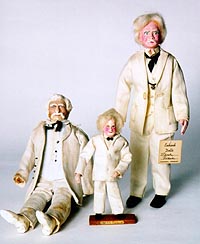
The Twain doll on the left may date from
Twain's lifetime, but was certainly made no later than the
1920s. The doll on the right is a Eubank doll made in
Hannibal, Missouri in the 1930s or early 1940s by Wilma
Eubank Pulliam, and the smaller doll at center is a
Courtney doll of later vintage. |
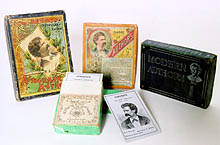
THE GAME OF AUTHORS was a popular card game,
first manufactured in 1861, and has been produced in more
than 200 different versions since. By 1869, Twain was being
included in decks. The deck shown in front dates from 1873,
and the other three all picture Twain himself on the lid of
the box, dating from the 1880s to 1910. |
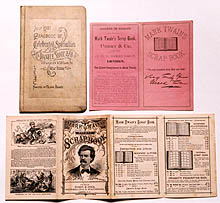
Twain patented his self-pasting scrapbook in
1873 and contrary to a popular myth, it was a success. The
folding advertising leaflet at bottom is American; the pink
leaflet is English, and the catalogue at left dates from
1901 and lists the dozens of formats and bindings
available. |
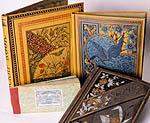
Twain's scrapbook came in various leather
bindings, a variety of cloth bindings, and even in pocket
size manilla covers. |
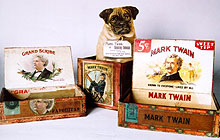 Twain was widely associated with
cigar-smoking, and cigar makers found it profitable to use
his image and name. The box at left dates from 1889, the
box at center from 1909, and the box at right was first
used in 1913 and was still in use in the 1930s. The "pug"
dog sitting in the middle box was a "counter card" that sat
on a drugstore counter to advertise Mark Twain Tobacco. His
back legs were hinged to allow him to "stay" all day on the
counter. Twain was widely associated with
cigar-smoking, and cigar makers found it profitable to use
his image and name. The box at left dates from 1889, the
box at center from 1909, and the box at right was first
used in 1913 and was still in use in the 1930s. The "pug"
dog sitting in the middle box was a "counter card" that sat
on a drugstore counter to advertise Mark Twain Tobacco. His
back legs were hinged to allow him to "stay" all day on the
counter. |
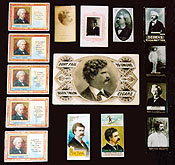
Insert cards were popular in tobacco
products, and Twain was a popular subject. The five cards
at left were issued in 1909 by Mogul Egyptian Cigarettes;
the large card at center was issued by Heppenheimer in New
York in the 1880s; the three small cards at top (from left
to right) were issued by Lone Jack (1887), Lever Brothers
(1901), and Vice-Regal (1904); the two pieces at bottom are
a card and biographical booklet issued by Duke Cigarettes
in 1887; and the four cards at right were all issued by
Ogden's between 1901 and 1905. |
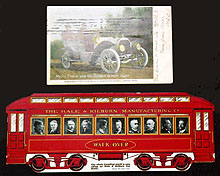
Twain was known for his wide travels, which
made his image especially useful to those in the travel
industry. Oldsmobile used this picture postcard of Twain to
advertise their motor cars in 1906, and Pullman used Twain
to advertise it's new passenger train car in 1904. Riding
the car with Twain were Theodore Roosevelt, Thomas Edison,
and others. |
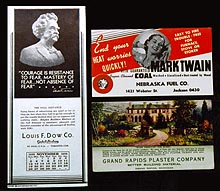
When fountain pens were still in popular use,
blotters were an essential desk item, and were a common
means of advertising. The blotter at left dates from 1933
with a timely quote by Twain about fear. The blotter at top
for Mark Twain Coal dates from 1952, and the blotter at
bottom for Grand Rapids Plaster (which may or may not have
been used at Twain's home, Stormfield) dates from
1911. |
|
CLICK INSIDE IMAGES TO
ENLARGE ANY ITEM
|
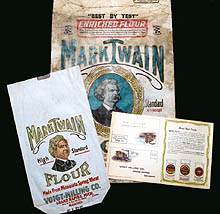
Mark Twain Flour was introduced in 1900, just
two years after this company began milling flour. Shown are
two sizes of their flour sacks, and the advertising leaflet
announcing their new brands. Mark Twain flour was made
until just a few years before the company closed in
1955. |
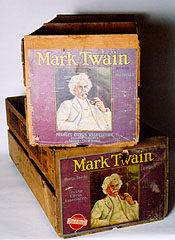
This company registered their trademark in
1918, and began marketing Mark Twain lemons and oranges in
1923. |
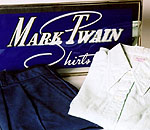
Starting in the 1940s Mark Twain Shirts were
manufactured. This glass counter sign was designed to hold
a light bulb. Shown are a Mark Twain shirt and a pair of
Mark Twain pants. |
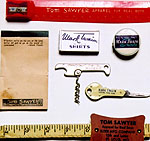
Mark Twain Shirts were advertised with
tape-measures, rulers, pencil sharpeners, notepads (with
Twain quotes on each page), corkscrews, and razors. Also
shown is a pen knife advertising Mark Twain Shoes. |
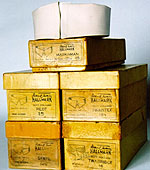
Shirts with separate collars were once
popular (you could change and wash the collar instead of
the whole shirt). Shown are boxes of five different styles
of Mark Twain Collars made by Hall & Hartwell, who
patented their Mark Twain collar in 1921 and began
production the next year. This nearly concludes a complete
Mark Twain wardrobe: shirts, collars, pants, and shoes. We
have yet to find Mark Twain socks and underwear, and the
only Mark Twain brand womens clothing we have seen are Mark
Twain mink coats. |
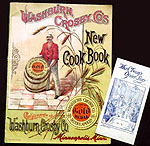
Mark Twain attended many dinners, especially
toward the end of his life and was famous for his
after-dinner speeches, so food makers felt entitled to his
name. This 1894 cookbook includes a description of Mark
Twain Beef Steak, and the 1910 advertising pamphlet for
Sealshipt Oysters includes a story about Twain and William
Dean Howells sitting down to an oyster dinner. |
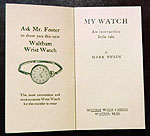
Waltham Watch Company published this Twain
story in 1918 to promote its watches. |
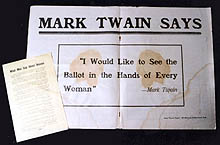
Twain was an early advocate for womens
suffrage and was often quoted in the press. The poster was
issued in 1910, and the small broadside was issued in 1909
or 1910. |
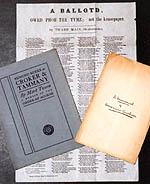 Twain's endorsement of a political cause was
a powerful force. The Twain pamphlet at left was issued in
opposition to Richard Croker, a New York mayoral candidate
of Tammany Hall fame. The pamphlet at right was issued by
the New York Copyright League in 1885 or 1886 to push for
copyright reform. It carried the facsimile signatures of
Twain, Louisa May Alcott, Sarah Orne Jewett, Joel Chandler
Harris, W. D. Howells, Whittier, Holmes, and a host of
other authors. The large broadside was issued in Hartford
in 1871 and used Twain's name. Badly written, there is no
internal evidence of Twain's having anything to do with it,
and it is not mentioned in his letters or notebooks of the
period; he may not have even known his name had been
appropriated.
Twain's endorsement of a political cause was
a powerful force. The Twain pamphlet at left was issued in
opposition to Richard Croker, a New York mayoral candidate
of Tammany Hall fame. The pamphlet at right was issued by
the New York Copyright League in 1885 or 1886 to push for
copyright reform. It carried the facsimile signatures of
Twain, Louisa May Alcott, Sarah Orne Jewett, Joel Chandler
Harris, W. D. Howells, Whittier, Holmes, and a host of
other authors. The large broadside was issued in Hartford
in 1871 and used Twain's name. Badly written, there is no
internal evidence of Twain's having anything to do with it,
and it is not mentioned in his letters or notebooks of the
period; he may not have even known his name had been
appropriated. |
|
CLICK INSIDE IMAGES TO
ENLARGE ANY ITEM
|
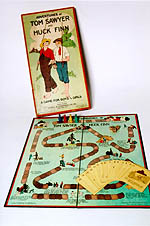
In advertising pieces issued after Twain's
death, Tom Sawyer and Huck Finn are nearly always pictured
fishing. This board game was issued by Stoll, Edwards in
1925, and came with four playing pieces, fifteen cards,
three dice, and took the players through various
adventures. |
 This very dangerous fishing game was made by
Keystone Wood Toys in the 1930s or 1940s, and involved
spring-loaded fish that could be "caught" using the two
fishing poles and lures supplied. More often than not, the
fish simply spring past the poles toward the eyes of the
players.
This very dangerous fishing game was made by
Keystone Wood Toys in the 1930s or 1940s, and involved
spring-loaded fish that could be "caught" using the two
fishing poles and lures supplied. More often than not, the
fish simply spring past the poles toward the eyes of the
players. |
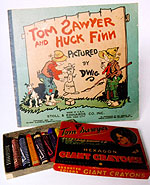
Stoll, Edwards issued this comic book in
1925; the crayons date from the 1940s, and at least two
different Twain-related coloring books are also known. |
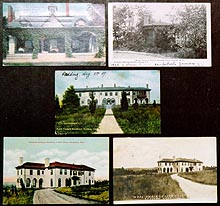
Visitors to historical sites associated with
Twain could send postcards to their friends. The top two
cards depict the Crane home at Quarry Farm near Elmira, New
York, where Twain summered, and the study at Quarry Farm
where he wrote HUCKLEBERRY FINN. They date from 1906. The
other three cards show Twain's last home at Stormfield and
date from 1908-1910, while Twain still lived there. The top
card was used by a member of the Stormfield household. |
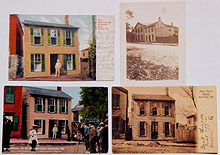
These four postcards show Twain's boyhood
home in Hannibal and date from 1904 to 1910. Three of the
cards are commercial cards sold to visitors. But the card
at upper right is an actual photograph of the home taken by
a visitor who had it printed out as a postcard. |
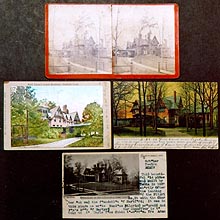
At top is a stereoview of Twain's Hartford
home by R. S. De Lamater. It dates from about 1875 when
Twain was living in the home. Stereoviews were a popular
way to memorialize a visit, and at least half-a-dozen
different stereoviews of his home are recorded. The three
postcards dated from 1898-1906, some years after Twain and
his family had moved. |
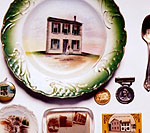
Early visitors to Hannibal could buy Wheelock
China plates and sweet dishes (1902-1915) and sterling
silver spoons. This spoon is engraved 1902, the same year
Twain himself returned to Hannibal to visit his boyhood
home. Also shown are paperweights, badges, and a celluloid
mirror, all dating from 1902 to 1920. |
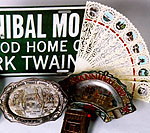
Later visitors to Twain's boyhood home could
remember their visit with fans, license tags, ashtrays, and
even a notepad holder and miniature pencil. These tourist
souvenirs date from the 1930s and 1940s. |
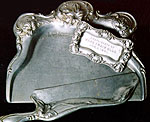 This dust pan, crumb sweeper (known as a
silent butler), and tray were issued on January 1, 1901 for
members of the Mark Twain Club. The earliest known Mark
Twain Club had been established in Ireland in 1875, and
another in New York (possibly the club that issued this
set) consisted of thirty-two members, including twelve
women. Unlike modern fan clubs, these clubs were reading
clubs that read and discussed Twain's works.
This dust pan, crumb sweeper (known as a
silent butler), and tray were issued on January 1, 1901 for
members of the Mark Twain Club. The earliest known Mark
Twain Club had been established in Ireland in 1875, and
another in New York (possibly the club that issued this
set) consisted of thirty-two members, including twelve
women. Unlike modern fan clubs, these clubs were reading
clubs that read and discussed Twain's works. |
|
CLICK INSIDE IMAGES TO
ENLARGE ANY ITEM
|
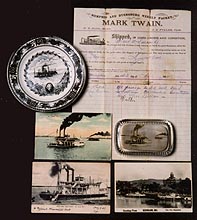 Twain's association with steamboats
dates from the publication of LIFE ON THE MISSISSIPPI. The
bill of lading is from the steamboat mail packet Mark Twain
that operated out of Memphis and dates from April 23, 1882.
Sometime between May 6 and 21, 1882, Twain himself saw this
very steamboat as he floated down the Mississippi toward
New Orleans, and in the opening lines of chapter 28 of LIFE
ON THE MISSISSIPPI he expressed surprise at the honor of
having a steamboat named after him, but could not help but
add that he thought the honor was long overdue. The plate
dates from 1935, and the postcards (1902-1912) show the
steamboat rechristened in Twain's honor in 1902 when he
visited St. Louis; Twain himself piloted that steamboat
around the harbor. Twain's association with steamboats
dates from the publication of LIFE ON THE MISSISSIPPI. The
bill of lading is from the steamboat mail packet Mark Twain
that operated out of Memphis and dates from April 23, 1882.
Sometime between May 6 and 21, 1882, Twain himself saw this
very steamboat as he floated down the Mississippi toward
New Orleans, and in the opening lines of chapter 28 of LIFE
ON THE MISSISSIPPI he expressed surprise at the honor of
having a steamboat named after him, but could not help but
add that he thought the honor was long overdue. The plate
dates from 1935, and the postcards (1902-1912) show the
steamboat rechristened in Twain's honor in 1902 when he
visited St. Louis; Twain himself piloted that steamboat
around the harbor. |
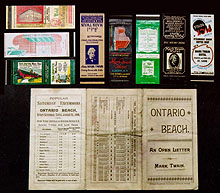 Dozens of hotels across the country
have called themselves "The Mark Twain Hotel." The first
one was in Hannibal, and it comes as no surprise to find
such hotels in St. Louis and Elmira, but these matchbook
covers, dating from 1920 to 1950, include Mark Twain Hotels
from Detroit, Minneapolis, Chicago, Gainesville, and even
Hollywood. The 1889 advertising brochure for the Ontario
Beach resort contains a letter supposedly written by Twain
extolling their virtues. Places that Twain visited often
used his name to promote themselves, but so did hotels and
resorts where he never set foot. Dozens of hotels across the country
have called themselves "The Mark Twain Hotel." The first
one was in Hannibal, and it comes as no surprise to find
such hotels in St. Louis and Elmira, but these matchbook
covers, dating from 1920 to 1950, include Mark Twain Hotels
from Detroit, Minneapolis, Chicago, Gainesville, and even
Hollywood. The 1889 advertising brochure for the Ontario
Beach resort contains a letter supposedly written by Twain
extolling their virtues. Places that Twain visited often
used his name to promote themselves, but so did hotels and
resorts where he never set foot. |
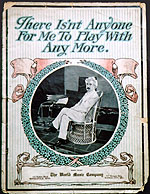
This photo of Twain sitting in a wicker chair
at Stormfield was used to boost sales of this sheet music
by H. L. Baldwin in 1911. |
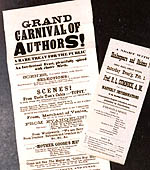
During his lifetime Twain was plagued by
people who traveled around the country impersonating him.
Some did this as a fraud and left their hotel bills unpaid.
Others were legitimate impersonators -- proto-Hal
Holbrooks. As these two broadside advertising sheets
attest, Twain was in good company. These programs included
readings from Twain, Shakespeare, Harriet Beecher Stowe,
Charles Dickens, Tennyson, and Walter Scott. The larger one
dates from 1876, and the other is of the same period. |
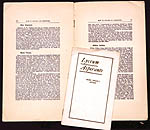
Twain's fame as a lecturer and stage
performer made him a natural spokesman for the profession.
A turn-of-the-century New England school printed Twain's
advice to wannabe writers, and the leaflet from J. B. Pond
(Twain's own lecture agent) gave Twain's advice to would-be
lecturers. |

Twain's quote about Hawaii was used on a
variety of printed materials that promoted the Hawaiian
tourist trade, but this appearance on a 1916 guitar
instruction book is unusual. |

Twain's visit to Hawaii in the 1860s resulted
in a quote that was widely used to promote Hawaiian
tourism. Shown here are a 1906 postcard, a 1908 tourist
guide, and the first separate printing of a Twain story
printed in Hawaii in the 1920s. |
 Twain lent his name to a variety of
charitable causes. The Congo Reform Association listed
Twain on its 1906 fund-raising letterhead. When his lecture
agent died in 1903, he helped raise money for the widow and
son left behind, and at right is shown an invitation from
Twain to his nephew for a benefit performance of THE PRINCE
AND THE PAUPER.
Twain lent his name to a variety of
charitable causes. The Congo Reform Association listed
Twain on its 1906 fund-raising letterhead. When his lecture
agent died in 1903, he helped raise money for the widow and
son left behind, and at right is shown an invitation from
Twain to his nephew for a benefit performance of THE PRINCE
AND THE PAUPER. |

The log cabin where Abraham Lincoln was born
was sold in 1894 and dragged around the country as a
side-show attraction. In 1906, Twain and some others bought
the cabin and established the Lincoln Farm Association to
buy the original farm so the cabin could be returned to its
original location and preserved. Twain, Roosevelt, Taft,
Samuel Gompers, and others all signed on, and they raised
over $350,000 between 1906 and 1909. The Lincoln Farm was
made a national park in 1916. Shown here are the
fund-raising leaflet and the certificate sent to those who
sent donations. |

In 1907 the Actor's Fund of America held a
fund-raiser in New York City. Twain lent his name to their
promotional materials for the event, and even sat in a
booth signing autographs during the fair. Shown are a
promotional letter with Twain's mimeographed endorsement,
and a copy of THE ADVENTURES OF TOM SAWYER signed at the
event by Twain, with the sticker still present. |
|
CLICK INSIDE IMAGES TO
ENLARGE ANY ITEM
|

In 1907, Twain name was invoked in this
packet of advertising material sent out to promote a stock
offering for a recording device that could be attached to a
phone and recorded the sound on electro-magnetic disks
about the same size as modern CDs. |

This maker of shaving soap used famous faces
to promote their product in 1903. Among the faces were
Twain, Roosevelt, Kipling, Paderewski, J. P. Morgan, Thomas
Edison, General Nelson Miles, and J. P. Bryan. |
 Twain crossed the Atlantic several times, and trans-Atlantic steamship lines used him to
promote their business. Twain wrote a letter praising the
bravery of a Cunard Line crew that saved people from a
storm-tossed steamer in 1872, and in 1873 they reprinted
his letter in their promotional leaflet. In 1896 the North
German Lloyd Line got hold of a Twain letter explaining his
scheme to steam back and forth across the Atlantic writing
a book, and printed it the souvenir booklet they gave
passengers.
Twain crossed the Atlantic several times, and trans-Atlantic steamship lines used him to
promote their business. Twain wrote a letter praising the
bravery of a Cunard Line crew that saved people from a
storm-tossed steamer in 1872, and in 1873 they reprinted
his letter in their promotional leaflet. In 1896 the North
German Lloyd Line got hold of a Twain letter explaining his
scheme to steam back and forth across the Atlantic writing
a book, and printed it the souvenir booklet they gave
passengers. |

Twain encouraged this woman to collect her
fictional letters into a book and she took his advice. She
also borrowed an extract from his speech to the Associated
Press praising her work by printing it in a promotional
leaflet for her book. Shown are the 1908 book (in dust
jacket), the promotional leaflet, and a promotional cabinet
photograph of the author. Using the words of one author to
puff the writings of another was nothing new, but Twain was
victimized more than most. |

John Knox was a famous Scotchman whose home
in Edinburgh was the oldest private residence in the city,
and Twain praised this 1898 book about Knox and his house.
When a new edition was published in 1905, Twain's letter of
praise was extracted and printed on a promotional
card. |





 Twain was widely associated with
cigar-smoking, and cigar makers found it profitable to use
his image and name. The box at left dates from 1889, the
box at center from 1909, and the box at right was first
used in 1913 and was still in use in the 1930s. The "pug"
dog sitting in the middle box was a "counter card" that sat
on a drugstore counter to advertise Mark Twain Tobacco. His
back legs were hinged to allow him to "stay" all day on the
counter.
Twain was widely associated with
cigar-smoking, and cigar makers found it profitable to use
his image and name. The box at left dates from 1889, the
box at center from 1909, and the box at right was first
used in 1913 and was still in use in the 1930s. The "pug"
dog sitting in the middle box was a "counter card" that sat
on a drugstore counter to advertise Mark Twain Tobacco. His
back legs were hinged to allow him to "stay" all day on the
counter.




















 Twain's association with steamboats
dates from the publication of LIFE ON THE MISSISSIPPI. The
bill of lading is from the steamboat mail packet Mark Twain
that operated out of Memphis and dates from April 23, 1882.
Sometime between May 6 and 21, 1882, Twain himself saw this
very steamboat as he floated down the Mississippi toward
New Orleans, and in the opening lines of chapter 28 of LIFE
ON THE MISSISSIPPI he expressed surprise at the honor of
having a steamboat named after him, but could not help but
add that he thought the honor was long overdue. The plate
dates from 1935, and the postcards (1902-1912) show the
steamboat rechristened in Twain's honor in 1902 when he
visited St. Louis; Twain himself piloted that steamboat
around the harbor.
Twain's association with steamboats
dates from the publication of LIFE ON THE MISSISSIPPI. The
bill of lading is from the steamboat mail packet Mark Twain
that operated out of Memphis and dates from April 23, 1882.
Sometime between May 6 and 21, 1882, Twain himself saw this
very steamboat as he floated down the Mississippi toward
New Orleans, and in the opening lines of chapter 28 of LIFE
ON THE MISSISSIPPI he expressed surprise at the honor of
having a steamboat named after him, but could not help but
add that he thought the honor was long overdue. The plate
dates from 1935, and the postcards (1902-1912) show the
steamboat rechristened in Twain's honor in 1902 when he
visited St. Louis; Twain himself piloted that steamboat
around the harbor. Dozens of hotels across the country
have called themselves "The Mark Twain Hotel." The first
one was in Hannibal, and it comes as no surprise to find
such hotels in St. Louis and Elmira, but these matchbook
covers, dating from 1920 to 1950, include Mark Twain Hotels
from Detroit, Minneapolis, Chicago, Gainesville, and even
Hollywood. The 1889 advertising brochure for the Ontario
Beach resort contains a letter supposedly written by Twain
extolling their virtues. Places that Twain visited often
used his name to promote themselves, but so did hotels and
resorts where he never set foot.
Dozens of hotels across the country
have called themselves "The Mark Twain Hotel." The first
one was in Hannibal, and it comes as no surprise to find
such hotels in St. Louis and Elmira, but these matchbook
covers, dating from 1920 to 1950, include Mark Twain Hotels
from Detroit, Minneapolis, Chicago, Gainesville, and even
Hollywood. The 1889 advertising brochure for the Ontario
Beach resort contains a letter supposedly written by Twain
extolling their virtues. Places that Twain visited often
used his name to promote themselves, but so did hotels and
resorts where he never set foot.














